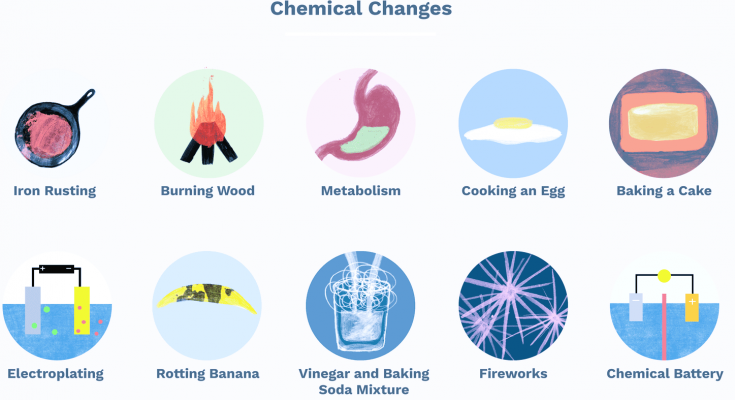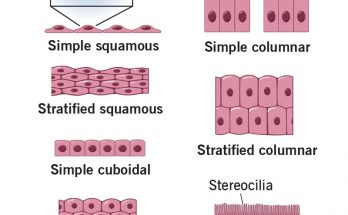Chemical changes are everywhere, from the food we cook to the stars in the sky. They’re processes where substances change into something new, different from what they were. This article will take you on a journey to explore various examples of chemical changes. From the labs where scientists discover new reactions to the industrial processes that make everyday products, we’ll see how these changes shape our world. Understanding these examples will help you see the amazing science happening all around us.
Table of Contents
20 Plus List of Chemical Changes Examples
Chemical Changes Examples in Everyday Life
Cooking and Cleaning
- 1.Cooking- When we cook food like baking bread or frying eggs, it’s not just about heating. These processes cause the ingredients to undergo chemical changes, transforming them into delicious meals.
- 2. Cleaning- Using cleaning agents, like detergents or bleach, leads to chemical reactions that break down stains or kill germs.
In Our Bodies-
- 3. Digestion– Eating isn’t just about satisfying hunger. When we digest food, our bodies perform chemical changes to break it down into nutrients and energy.
- 4. Breathing– Breathing might seem simple, but it’s a complex chemical process where our bodies exchange oxygen and carbon dioxide.
Laboratory Insights- Examples of Chemical Changes
- 5. School Science Projects- In schools, students often see chemical changes through simple experiments like mixing vinegar and baking soda to create a bubbling reaction.
- 6. Professional Lab Research- In more advanced labs, scientists use chemical reactions to create new medicines or study reactions that can’t be seen with the naked eye. These experiments help in understanding complex chemical processes and discovering new substances.
Also Check – 50 Examples of Physical Changes
Industrial Manufacturing and Chemical Changes
- 7. Plastic Production- Raw materials like crude oil are chemically transformed into various types of plastics.
8. Metal Refining and Smelting- Ores are processed through chemical reactions to extract pure metals.
- 9. Fertiliser Production- Chemical processes are used to create fertilisers for agriculture, combining elements like nitrogen, phosphorus, and potassium.
Environmental Impact- Chemical Changes Examples
- 10. Decomposition in Ecosystems- Decomposition is a key chemical change where dead organic matter is broken down into simpler substances, essential for nutrient recycling in ecosystems.
- 10. Photosynthesis in Plants– Photosynthesis is another crucial chemical change. Plants convert carbon dioxide and water into oxygen and glucose, using sunlight. This process not only sustains plant life but also supports life on Earth by producing oxygen.
Also Check – Differences between Physical and Chemical Changes
Food Processing- Chemical Changes in Action
- 11. Fermentation- Used in making bread, cheese, yoghurt, and alcoholic beverages.
- 12. Canning- Involves heating food to kill bacteria and seal it in sterile containers.
- 13. Pickling- Preservation using vinegar or brine, causing chemical changes in the food.
- 14. Browning of Fruits and Vegetables- Enzymatic browning occurs when cut, exposed to air.
Energy Generation- Chemical Changes at Work
- 15. Fermentation- This is a process where microorganisms like yeast and bacteria chemically alter food, creating products like yoghurt, cheese, and bread.
- 16. Canning- In canning, food undergoes chemical changes due to heat treatment, which helps preserve it for longer periods
Exploring Space- Chemical Changes in Astronomy
Star Life Cycles-
- 17. Nuclear Reactions in Stars– Stars, like our sun, undergo nuclear reactions where hydrogen atoms fuse to form helium. This fusion process is a powerful chemical change that releases immense energy, supporting the star’s brightness and heat
Biological Systems and Chemical Reactions
Metabolic Reactions in Organisms-
- 18. Photosynthesis– Plants convert carbon dioxide and water into glucose and oxygen using sunlight.
- 19. Cellular Respiration– Cells break down glucose into energy, carbon dioxide, and water.
- 20. Enzymatic Digestion- Enzymes in the body break down complex food molecules into simpler substances.
- 21. Protein Synthesis- Cells construct proteins from amino acids, essential for growth and repair.
Cosmetic and Pharmaceutical – Chemical Changes Examples
Creation of Health and Beauty Products-
- 22. Cosmetics Production- The creation of cosmetics involves chemical changes to develop products like creams, lotions, and makeup.
- 23. Pharmaceuticals Development- In pharmaceuticals, chemical changes are critical in formulating drugs that can cure or manage diseases, involving complex chemical syntheses.
Curious Queries on Chemical Changes
Can a chemical change in cooking make food healthier?
Answer- Yes, some cooking methods can increase nutrient availability or reduce harmful compounds.
Do astronauts observe different chemical changes in space?
Answer- Yes, the microgravity environment can affect chemical reactions, leading to different outcomes compared to Earth.
Could chemical changes be used to create new types of energy?
Answer- Potentially, research into chemical changes could lead to new, sustainable energy sources.
Are there any chemical changes that are beneficial for the environment?
Answer- Yes, certain chemical processes, like those used in water treatment, are beneficial for the environment.
Can chemical changes in pharmaceuticals lead to discoveries of new cures?
Answer- Absolutely, many medical breakthroughs come from understanding and applying chemical changes.
How do chemical changes in food affect allergies?
Answer- Some cooking processes can reduce allergens in foods, altering their chemical structure.
Can chemical changes in the atmosphere affect weather?
Answer- Yes, reactions like ozone formation can influence weather patterns and climate.
Do chemical changes contribute to smartphone battery life?
Answer- Absolutely, the efficiency of chemical reactions in batteries impacts their lifespan and performance.
Why do leaves change colour in autumn through chemical changes?
Answer- Chemical changes in leaves reduce chlorophyll production, revealing other pigments.
Can we reverse environmental damage through chemical changes?
Answer- Certain chemical processes can help mitigate environmental damage, like removing pollutants.
Are there chemical changes involved in making biodegradable plastics?
Answer- Yes, creating biodegradable plastics involves chemical processes that allow them to break down naturally.
Do chemical changes in fermentation improve the nutritional value of food?
Answer- Fermentation can increase vitamin levels and improve digestion.
How do chemical changes in recycling processes work?
Answer- Recycling often involves breaking down materials into basic components and reforming them.
Can chemical changes in cooking make food taste different?
Answer- Yes, cooking can enhance flavours through chemical reactions like caramelization.
Are there chemical changes in space similar to Earth?
Answer- While fundamental chemical principles are the same, conditions in space can lead to different reaction pathways or rates.

